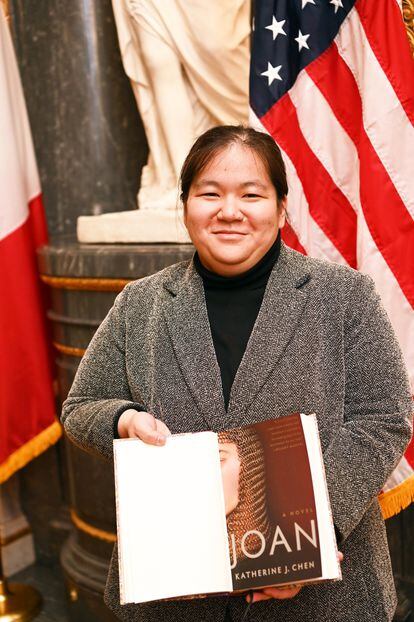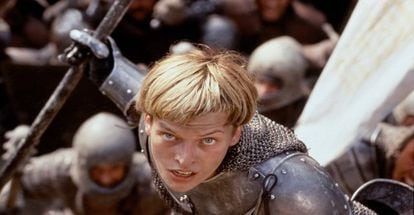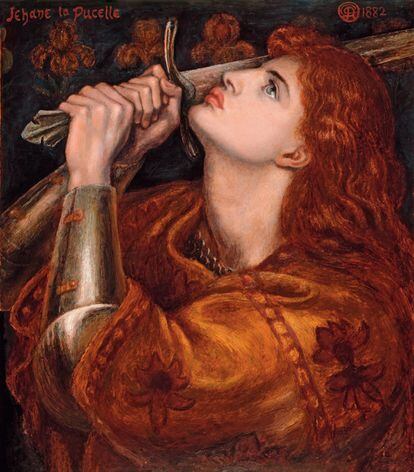Joan of Arc, the historical French heroine burned for heresy at the stake in Rouen in 1431 (she was burned three times, so that there would be no doubt, nor remains that could serve as a reminder, on the second the braincase and abdominal cavity exploded and some pieces splashed on spectators, according to witnesses), it has had many representations in art, literature, theater or cinema. Thinking about it evokes, among many other images, that of the resplendent, triumphant golden equestrian statue in the Place des Pyramids in Paris; the ascetic and tormented face of Renée Jeanne Falconetti in The Passion of Joan of Arc by Carl Theodor Dreyer (1928), that by Ingrid Bergman (in duplicate: in Joan of Arc, by Victor Fleming, from 1948, and Joan at the stakeby Rossellini, from 1954), that of Florence Delay (Process of Jeanne d'Arcby Robert Bresson, 1962), that of a very young Jean Seberg (Saint Joanby Otto Preminger, 1957) or the very carnal face and body of Milla Jovovich in Luc Besson's 1999 film, where the actress showed how sensual it can be to wear armor.
On pucellethe damsel, from Orléans – who by the way was not from there or from Arco (her father's surname), but from Domrémy, today Domrémy-la-pucelle, in Lorraine – have been written since Shakespeare, who did not leave her very well in its Henry VIwhere it is labeled “ugly witch“, ugly witch, and “strumpet”, little bitch (which is logical because she was the sworn enemy of the English and ruined a century of victories in France) to Michel Tournier (Gilles and Juana, Alfaguara, 1989): “Don't you see the purity that radiates from his face? There is innocence in all his flesh, yes, an almost childlike innocence, and a light that is not of this earth.” Passing through Schiller, Anatole France, Peguy, Bernard Shaw, Claudel, Bertolt Brecht, and Anouilh (L'alouette), without forgetting the song that Leonard Cohen dedicated to him: “Now the flames they followed Joan of Arc as she came riding through the dark”.
It would seem that everything is said and done about Juana, but now comes a historical novel that gives a surprising twist to the character. In Joan of Arc, by Katherine J. Chen (Destino, 2024, translation from English by Montse Triviño), the protagonist is a very masculine, corpulent and ugly young woman (nothing to do with the pretty, innocent and dreamy girl on the controversial Spanish cover of the book generated by IA, although the author likes it). She is a virago with broad shoulders and poor hygiene who unexpectedly reveals herself to be a lethal warrior and whose capacity for fighting and resistance—revealed since she was a child—comes from having endured beatings by her father all her life. Without visions of the archangel Michael or the saints Margaret of Antioch and Catherine of Alexandria, she is very earthly, her strength does not come from God, nor from holiness, but from enduring abuse. Her gifts have been beaten into him. Nor is her motivation for marching against the English one of Juana's classics (religiosity and love of France) but simply the desire to avenge her raped and murdered sister. She is a Juana, Chen's, without miracles or splendor, all tenacity and empowerment.
The novelist points out the paradox that to create her fictional Joan, “a great challenge” (she wrote three drafts), she has had to be realistic with the historical Joan. “Visions play a very important role in Juana's story, but it is very difficult to incorporate them in a novel. When trying to write about her I ran into the problem that her gaze as a character was above me, as if gravitating. It is the look that portraits and movies offer. And I wanted her to look at me and the reader on the same plane.” Furthermore, “Joana's story has been appropriated by so many, in France even by the extreme right, that to make it my own I had to find my own approach.” He considers that there is “a common trap in the historical novel that consists of regurgitating the biography of a historical figure, and it should not be done that way, you must avoid falling into the pool of data during your research, try to stay afloat like a child with muffs. You have to find the right tone, so that you don't lose the fact that you are in medieval times, but with a contemporary perspective, that can be relevant today.”
Chen (Wayne, New Jersey, 33, Princeton graduate) says she wanted to read between the lines of Juana's story to find the one that interested her. “In the interrogations that lead to her execution, I find a very strong and tough Juana, proud in front of the court, who refuses to follow the game of her accusers. “A figure with a great personality.” Remember that, as her biographer Mary Gordon said, “Joan of Arc is a myth like Robin Hood or King Arthur, but unlike them she is firmly anchored in history, we have dates of her birth and death, and a multitude of testimonies. , even his own words.”

Of “the two iconic images of Juana, the woman in armor and the woman placed on the stake, I celebrate the first more,” she emphasizes. In fact, in her novel, which traces Joan's life since she was a child, reviewing all the canonical events (the meeting with the court and the dauphin in Chinon, the liberation of Orleans, the coronation of Charles VII in Reims in 1429, the rosary of victories and wounds followed by defeats when the king let her fall, and the capture by the Burgundians in 1430 and her delivery to the English) the execution scene does not appear. “There is that famous film, Dreyer's, with so much suffering, and recreating when they burn it; When I saw it it made me feel uncomfortable. Dreyer even made the actress herself suffer and there was even, it is said, royal blood. Others have not gone that far, but I have always found that image of Juana in the flames to be very tragic. Juana was 19 years old when she died. I intended to capture other aspects of her life. We already have many female martyrs in history, I wanted to investigate why Juana survives so much in her memory and the others do not. And the answer is not how she died. She was very reluctant to accept her punishment, she did not accept dying, contrary to what every good martyr does. She
was rebelling. I do not want to glorify her passion and her death.” So the book ends when they take her imprisoned in a cage to Ruan and she sees the sea for the first time.
Showing her beautiful didn't seem realistic to me.”
When asked about the decision to make Juana ugly, Chen refers to Bernard Shaw, who said that portraying Juana as beautiful turns any work about her into a romance. “It hit the nail on the head, and there's really no indication that Juana was attractive. Somewhere it is pointed out that her breasts were beautiful, but not her face, no one talks about her beauty. Showing her beautiful does not seem realistic to me.” As for making her big and strong, “she wore armor, and the armor weighed a lot, it is difficult for me to imagine Juana as small, she needed physical strength to ride an armed war horse, to handle a spear and a sword. Maybe she takes some liberty with me, but that's how I see it.” The Juana of the novel dresses as a man (one of the things for which she was convicted was for cross-dressing) and her hair is shaved in the military cut of the nobility. She is amazed in the novel by her ability to defeat professional knights, to immerse herself in the horror of battle or to shoot 12 accurate arrows per minute like the best archers.

Was Joan a great warrior like Chen shows? Was she decisive in the final phase of the Hundred Years' War and the final victory of France? It has been suggested that perhaps she was used only as a symbol and kept away from the fighting, carrying the banner in her hand. “I refer to the transcripts of her trial. There are eyewitnesses who described her, and a captain declared that Juana was simple or ignorant in everything, except what she had to do with the issues of war. She made a knight of her army move away from the place where she foresaw an English projectile was going to fall. She intuitively knew how a battle worked. We have testimonies that she was wounded in combat, and that – they saw her bathing – she had calluses on her buttocks, from riding. She certainly wasn't just a spiritual entertainer. She was a woman of action.”
Regarding the feminist perspective of her novel—an exciting novel, at times extraordinarily beautiful, with passages worthy of a medieval miniature—she says that it was inevitable to see Juana as an empowered woman and that she was not only interested in the element of feminism in her story. but also to emphasize the heroic, “to show how a human hero is constructed, an authentic one.” “My Joan,” she emphasizes, “she is a figure shaped by external forces, a woman of great strength who in the end has nothing, no armor, no sword, no army, no king, but she is still strong.”

Little sex in the novel, conditioned by Pucelle's chastity and virginity? “Virginity was very important for the historical Joan and it is for mine. It's always good to add sex to the narrative, but I couldn't do it. And it was part of the challenge to write about a female character in which there is no romantic love. She loves her sister, her uncle, her dog, and then the French people. But her virginity was very important historically, Juana was very proud of her and allowed herself to be explored several times to test her. That pride in her virginity was even one of the things they used against her in the process.”
The good things in life don't make you stronger; the bad ones yes”
The author surprises by explaining that there is some autobiographical element in her characterization of the character. “I grew up in a home with abuse and violence. My father didn't burn my dog like Juana's does in the novel, but he suffocated mine to death. I wonder how I got over that. “I put a lot of myself into the character of Juana.” That her character's motivation is to have been abused is harsh. “It is, yes, I speak for myself, who has experienced abuse at home as a child and adolescent. That made me who I am, and it weighs. But as a general rule, the good things in life don't make you stronger; the bad ones yes. “I wanted to show that in the book.”

useum)
Author of a previous novel, Mary B., the untold story of 'Pride and Prejudice' (Edhasa, 2019), a pastiche or spin-off of Jane Austen's work, Chen is a big fan of Hillary Mantel, the famous author of the series of historical novels about Thomas Cromwell and who was very complimentary of her Joan of Arc. Chen, who wrote the book without setting foot in France and while he was treating thyroid cancer, is working on his next novel, about the relationship between King Arthur and his half-sister and magician Morgana. While waiting for this new visit to the Middle Ages, it is difficult not to surrender before the image of her rude maid of Orleans, that great, practical and efficient Joan, who rides fiercely and kills like a man, but observes death with sadness. the eyes of a defeated enemy, and tears strips from his sacred banner to bind up the wounds of his soldiers.
All the culture that goes with you awaits you here.
Subscribe
Babelia
The literary news analyzed by the best critics in our weekly newsletter
RECEIVE IT
Subscribe to continue reading
Read without limits
_
#Joan #Arc #ugly #corpulent #victim #father39s #abuse #lethal #warrior #empowered #woman #action
